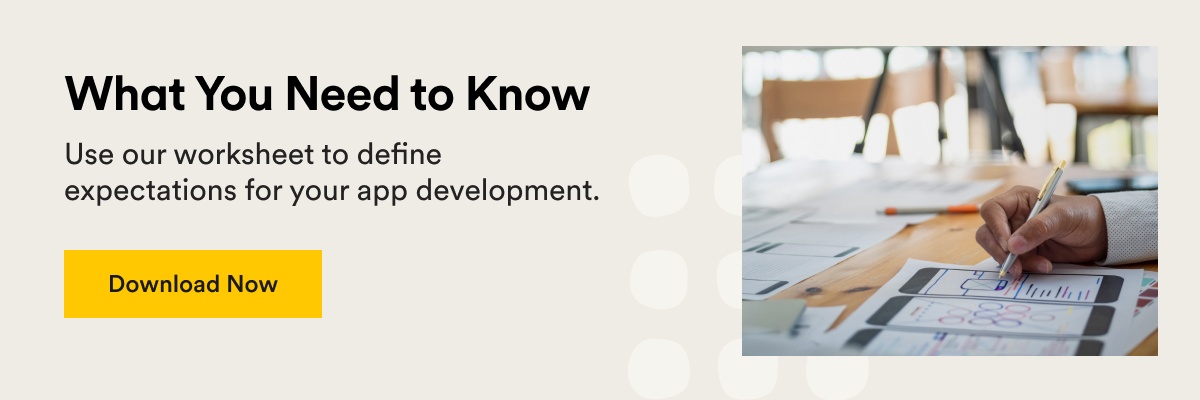
The software development industry works on projects and often devotes a core group to one project at a time. But software development teams have the power to make or break a project. That’s why you need a strategic team—and sometimes less is more.
Get the most return on investment by slowing down to speed up. Taking more time at the beginning of a project can set the stage for success. Learn why team size should be secondary, and how a small, experienced cross-functional team can deliver big results.
Define your expectations for mobile app development with our worksheet. >>
Get the right people in the right place.
More cooks in the kitchen don’t make food faster. Instead, duties will get mixed up and hot pans will crash to the floor. In software development, it’s most important to get the right people working on tasks. A small software development partner breaks down team members on a project, helping to define who does what. You’ll want to fill just five different functions.
UX Researcher
First things first. What do you want from your software product and what will your users want? A user-friendly experience (UX) researcher uses a combination of user testing and interviews to share your product concept, solicit feedback, and uncover new opportunities.
UI/UX Designer
Time to start painting that blank canvas. With research in hand, a UI/UX designer transforms your ideas into wireframes that illustrate an appealing user interface (UI) and UX. They also create graphics and prototypes to show how your app will behave, assisting developers who write the code.
Software Developers
It’s alive! Imagine if that perfect portrait jumped off the page and into the digital sphere. The software development team—complete with Android, iOS, frontend, and backend developers—builds your actual product, transforming language and graphics into code that devices understand.
QA Team
Does the software meet expectations? Quality assurance (QA) engineers develop and execute repeatable processes that check for security and quality. They test functionality and account for any unique requirements, alerting development of bugs to fix. Detroit Labs introduces our QA engineers at the beginning of the project, and they are engaged throughout the development lifecycle to deliver a better UX.
Project Management
But who keeps the whole thing moving? A project manager assigns tasks across design and development, managing team members’ time, challenges, and risks.
It’s worth noting that a delivery lead can also fill this function, as well as act as a client manager, scrum master, and business analyst. At Detroit Labs, we lean on delivery leads to do all of the above, plus:
- Act as primary points of contact.
- Oversee projects to delivery.
- Remove roadblocks for project teams.
- Maintain client and internal team expectations.
- Use metrics to motivate changes.
Have a clear timeline and stick to it.
You don’t need to hire a software development team that’s the biggest, but rather one that follows each stage of development the right way. Your core team should follow four established processes throughout a designated timeline.
Discovery
You need to know where you’re going to get there. Discovery is a weeks-long process that defines the project. While it may be tempting to say, “I know what I want, I don’t need discovery,” it’s a crucial step you can’t afford to skip. That’s because discovery helps to set expectations, reducing your risk and avoiding missteps. Use discovery to define:
- Project goals.
- Scope of work.
- Deadlines.
- User experience needs.
- A plan for building the app.
User Research
Remember the UX research we talked about earlier? Here, your researcher(s) will interview potential users and use secondary research to guide UX design, inform development, and maintain alignment among stakeholders to point your project in the right direction.
Product Roadmap
As your build progresses, work with your software development partner—and their designers, developers, and project manager—to create and follow a product roadmap that outlines your strategy. This means doing more research to create value propositions, assemble audience demographics, develop user stories, and define effort constraints. Along the way, you’ll also define roles and responsibilities and refine product features and requirements to help meet various SMART goals.
Development + MVP
“Teamwork makes the dream work.” Design and development work together to concept and create your minimum viable product (MVP). With designs ready, developers rely on best practices to execute priorities, fix bugs, perform acceptance testing, and refine your app.
Smaller teams may have fewer resources to work with, but they’re uniquely suited to move with you during your project. Think about how hard it is to get in touch with and get support from a larger organization. For example, imagine you’ve booked a doctor’s appointment with a practitioner at a large hospital network. In the office, perhaps they don’t remember you from the last time you visited, and are quick to prescribe medicine that relieves symptoms…but not necessarily your underlying health problem. Basically, you’re in and out as quickly as possible so they can meet their patient quota for the day. You could face a similar headache with a large software development partner, so thinking small can actually offer a more holistic, personalized experience.
Smaller teams—such as the software development team at Detroit Labs—are nimble. They have the flexibility to coordinate quickly and efficiently on key tasks, enabling quick responses to change. And because the team is tight-knit, individual members have stronger project ownership, which provides opportunities to impact your end product and work together toward common goals.
Use your product roadmap.
“A product roadmap is a shared source of truth that outlines the vision, direction, priorities, and progress of a product over time.” Treat your roadmap as this source of truth across all members of the team so your software development partner can define and work toward product goals.
Keep Referring Back to It
You didn’t get to where you are by doing everything the same, day in and day out. To move ahead in your career, you learned, refined, and improved as conditions changed. The same is true in development because roadmaps aren’t one-and-done; they continually evolve throughout your project.
As development on your software progresses, refer back to your product roadmap to refine and understand your “why.” Why are you building it and what do you want to accomplish? Reassessing helps you be responsive to changes based on customer feedback and the competitive landscape, plus it offers more chances for collaboration on how the product will grow and change.
When you work with a larger team, it’s easy to assume you can quickly scale to speed up your timeline and charge through your roadmap. But there’s a point of diminishing returns, because scaling up too quickly or at the wrong time can hurt your project velocity, team dynamics, and product quality. Starting with a small yet experienced team sets you up to grow responsibly, fostering transparency to move the project along.
Choose the Best Software Development Team
Size doesn’t matter—expertise does. When it comes to building your product, you need the right software development team structure and a dedication to time-tested development processes to be successful. Small software teams can give your project the attention it needs to thrive. Learn “What to Expect When Building an App” and get in touch to find out how Detroit Labs can help.
